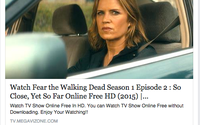 At a time when it seems as if TV
is, in fact, everywhere, I’d like to make an assertion that there’s only one place that really matters: in front of people who are watching it. Now that may seem like an obvious point, but
in a business that increasingly seems to be about the “platform,” it’s actually the people who are accessing it who count.
At a time when it seems as if TV
is, in fact, everywhere, I’d like to make an assertion that there’s only one place that really matters: in front of people who are watching it. Now that may seem like an obvious point, but
in a business that increasingly seems to be about the “platform,” it’s actually the people who are accessing it who count.
It’s something I’ve always
believed, even when platforms were few and far between. Take TV’s earliest fragmentation: cable TV. When I covered the emergence of “multichannel television” in the early 1980s,
study after study pointed out the differences between “broadcast” and “cable,” but when you actually asked consumers what they thought they were watching, they simply called it
“television.” Or, more likely, they said the names of their favorite TV shows.
advertisement
advertisement
Yes, there are distinctions that make every new distribution medium somewhat unique, but
they are mainly industrial issues like licensing, business models and scale.
It's not that business models don’t matter. They matter a great deal when it comes to viewers
actually getting access to programming; there's also the issue of whether business models can support the creation and distribution of shows. But we’re also discovering that when business models
get in the way of access, consumers still find a way to watch what they want.
Recently, I asked a college-age acquaintance of mine if she'd caught the premiere of AMC’s
“Fear the Walking Dead.” She’s a big fan of the original AMC series, “Walking Dead,” and was getting ready to leave for a semester abroad in Europe.
“No,” she replied, adding, “but don’t worry, I’ll catch it later.”
It was the catching it later part that is important to this column,
because she -- and many other young viewers -- know that business models are not necessarily an impediment to their on-demand viewing needs. Whether it is a pirate site or BitTorrent or some other
peer-to-peer means, they know how to get what they need, when they need it.
Don’t get me wrong. I’m not condoning those practices. Nor am I an expert on licensing law.
But I do know that when a behavior becomes so widespread that it’s no longer practically enforceable, that’s when revolutions happen. And I think many people in the industry are ignoring a
revolution that is happening, mainly because it's occurring in a part of the world they do not see for themselves. Industry efforts to curtail black and/or grey markets for accessing television
content should continue, even if they are likely to fail. Better would be to foster industry initiatives that facilitate what consumers want, in a way that's economically viable for the people who
make and distribute it.
Want a good example? Think music and iTunes. At a time when the music industry was growing apoplectic over piracy, Steve Jobs had the foresight to understand
that the issue wasn’t really piracy, but giving people access to what they wanted in a way that was simple -- and a reasonable value exchange. And yes, iTunes does distribute TV content, too. My
college student friend could even download episodes of “Fear the Walking Dead” there. But the problem is that the TV industry has made it too complicated for such behavior to be second
nature. Instead, potential viewers use social media to find the best available file to download.
I’m not sure what the solution is. I remember when Discovery Channel founder
John Hendricks launched Your Choice TV in the early 1990s, because he understood this latent consumer desire to access TV content on demand. The barrier was getting all the rights-holders to play
along, he said. He was right about that.
The real problem facing the TV industry, particularly the over-the-top segment, is that it simply isn’t a very good user experience.
And people are finding their own ways around it.
It’s not just a problem plaguing consumers. It’s what is keeping the ad industry from supporting sponsorship models that
would otherwise help underwrite the free, ubiquitous access of programming via connected TV consumers.
Significantly less than half (43%) of the Association of National
Advertisers’ members surveyed recently by the ANA and Brightline said they were “very” familiar with the connected TV and OTT marketplace. And only one in five (22%) said they had
used it as part of their TV advertising.
“Lack of familiarity” was cited as the No. 1 barrier, according to marketers responding to the survey.
I would say it is
really more about complexity, the same issue that is driving some consumers to bypass the legitimate connected TV marketplace entirely. Make it easier, and consumers and advertisers will connect.
Joe Mandese is filling in for "TV Everywhere" columnist J. Max Robins, who is on vacation this week.